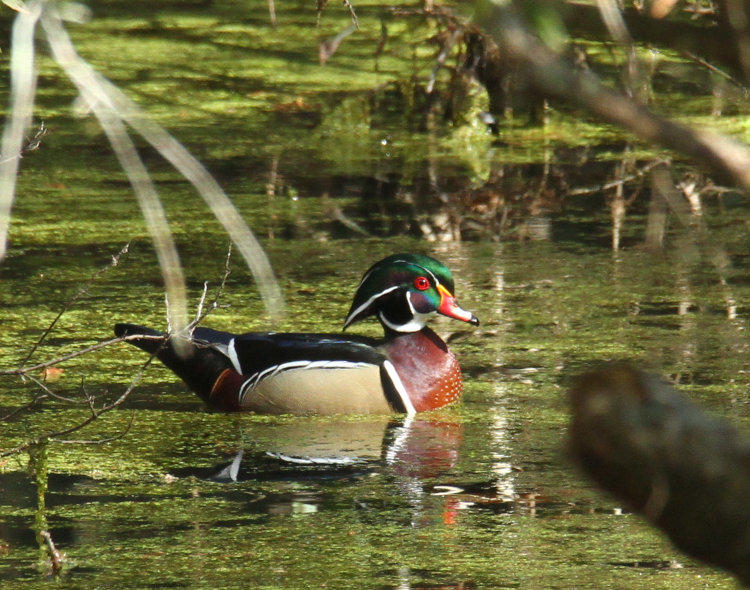A couple weekends back, The Girlfriend and I were checking out thrift stores in another town and came across a nice little wood duck figurine, fully painted. It became clear that the proprietor wanted much more for it than we were willing to pay, but it got me mildly determined, and of course when you have a 3D printer you have to check out the options. Sure enough, someone named milletro had a wood duck decoy on Thingiverse, apparently a 3D scan of an actual decoy, and I downloaded and printed it.
 But the proportions were off a bit, the head being too small and narrow, as well as too rounded on top – real wood ducks have rather oblong heads. So I reworked the model in Blender, a 3D modeling software – this was no small feat, because I don’t know how to do complex shapes very well, and so resizing and reshaping the head left behind some yucky artifacts. After I printed it, I had to do a little sanding, but at least the proportions seemed a lot closer to reality.
But the proportions were off a bit, the head being too small and narrow, as well as too rounded on top – real wood ducks have rather oblong heads. So I reworked the model in Blender, a 3D modeling software – this was no small feat, because I don’t know how to do complex shapes very well, and so resizing and reshaping the head left behind some yucky artifacts. After I printed it, I had to do a little sanding, but at least the proportions seemed a lot closer to reality.
[Original model in front, my rework in back.]
 Then, of course, I had to paint it. Interesting enough from the standpoint of mixing colors to try for the best match, and the details of the real ducks have a bit of variation – not in their coloration so much, but in how the details look depending on whether the neck is more extended or not, and how the wings sit across the back, and so on. This says nothing whatsoever of the iridescent feathers, which I had no decent way of emulating to any degree of accuracy – they do make iridescent paints, but they’re expensive and I’m not sure the effect is the same as wood duck feathers anyway. After several tries, I settled on a base coat of a metallic grey, overcoated with clear acrylic mixed with green or purple, which provided a colored sheen anyway. I mean, the actual bird feathers change color depending on the angle that you’re looking at them, as well as disappearing and simply appearing black in indirect light, but this was close enough to communicate the idea anyway. At least, I think so…
Then, of course, I had to paint it. Interesting enough from the standpoint of mixing colors to try for the best match, and the details of the real ducks have a bit of variation – not in their coloration so much, but in how the details look depending on whether the neck is more extended or not, and how the wings sit across the back, and so on. This says nothing whatsoever of the iridescent feathers, which I had no decent way of emulating to any degree of accuracy – they do make iridescent paints, but they’re expensive and I’m not sure the effect is the same as wood duck feathers anyway. After several tries, I settled on a base coat of a metallic grey, overcoated with clear acrylic mixed with green or purple, which provided a colored sheen anyway. I mean, the actual bird feathers change color depending on the angle that you’re looking at them, as well as disappearing and simply appearing black in indirect light, but this was close enough to communicate the idea anyway. At least, I think so…
The original paints that I used were matte, so I top-coated with a clear gloss acrylic, because duck feathers are waterproof of course, but I think it has a little too much shine to it and may have to re-coat it in semi-gloss, except for the eyes and iridescent feathers. The model itself is roughly 150mm in length, or about half life-size of the real thing – good size for a shelf, you know? Plus it kept the print time down to about two and a half hours. I’m pleased with the results, even when I see the small printing and painting mistakes that I made. And, of course, the new version was uploaded to my Thingiverse account.
[A small note: Licenses and attributions are a variable thing, though most people uploading designs to such sites do so under a ‘Creative Commons – Attribution’ standard. This means editing their designs is allowed, as long as you credit the originator, but commercial usage and sales are not allowed without express permission. There are still assholes that violate this – I’ve seen them a few times myself – but for the most part, the agreement is honored as part of the 3D printing community, and that’s how I was able to use and edit this one. Without mmilletro’s original, I would have made no progress at all because I simply can’t model shapes of this nature.]
More photos of the real things will be along shortly, even though I’m still trying to get a really nice portrait. They’re now visiting the yard routinely because we’re feeding them, but they’re still insanely wary of our presence and usually at least swim off, if not flying away to the lower pond, the moment they see us, so nearly all observations have been taking place through windows. Working on it…





















































